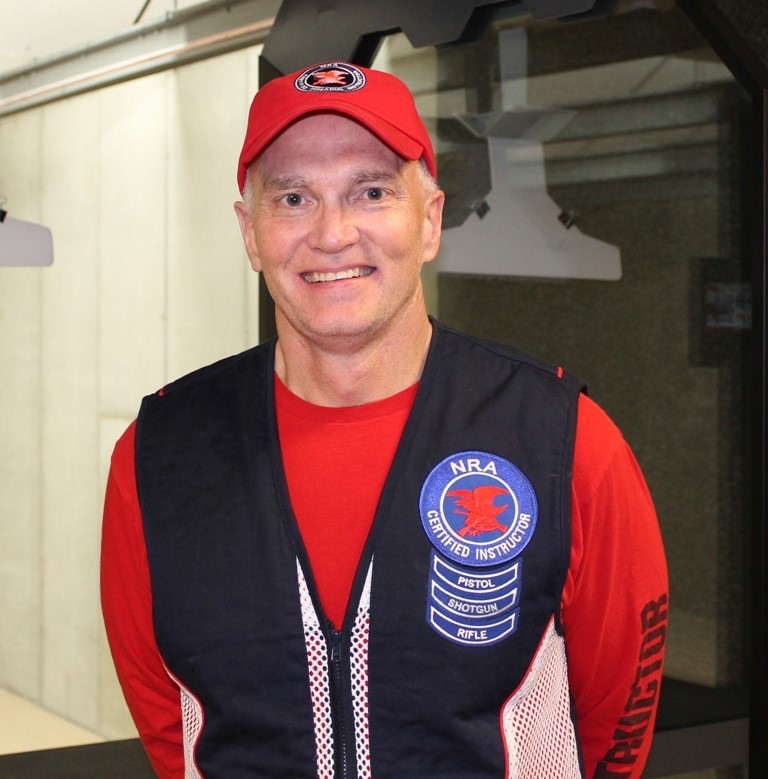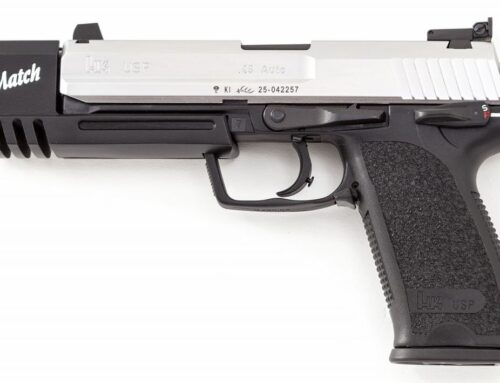A frequent topic with shooters is whether and/or how to shoot with both eyes open. Let me start by saying that it’s better if you do and that there are many options for how. The advantages to not closing an eye range from better vision in aiming to higher defensive situational awareness.
Put simply, closing one eye impacts the vision in the other. Think about when you visit the optometrist. Do they have you squint to read the eye chart? No, they have you keep both eyes open but then cover one with a flat spoon – i.e., an occluder. On the tactical side, closing one eye cuts out half of your field of view. This leaves you vulnerable to a second threat or other hazards. So whatever style of shooting you practice, you should learn how to do it with both eyes open.
To understand why your vision is better with both eyes open, you need to understand the changes in your eyes if you close (occlude) your non-aiming eye.
One reason for closing or occluding is to prevent diplopia (double vision) as we obtain our sight picture. Try looking at a clock about 15 feet way with both eyes open and focused on the clock. Now, while still focused on the clock, bring your hand with index finger pointed up into your sight line. You’ll now see two fingers. This occurs because each eye is seeing the finger from a different angle while both are focused on the clock. This is double vision and you’ve experienced it shooting if your front sight appears to move side to side a bit while trying to aim.
In addition, most of us know our pupils constrict with bright light and dilate with low light. When a light source is directed onto one eye, the pupil of that eye constricts due to the ‘direct light reflex.’ At the same time though, the pupil of the other eye also constricts, which is known as the ‘consensual light reflex.’ So, when we close the non-aiming eye while shooting, not only does that pupil dilate because of less light, but so does the pupil of the aiming eye.
When our pupil dilates (gets larger), we generally do not see as well. First, as pupil size increases, our depth of focus decreases along with a decrease to the depth of field. So even though our front sights may still be clear, the target will become more blurred. Second, when the pupil is larger, light rays may not converge onto the retina in a single point because of something called “spherical aberration”. With younger shooters, the positive spherical aberration from the cornea is compensated by the negative spherical aberration from the lens. This is a reason why younger eyes see better than older eyes. As we age, the spherical aberration from the cornea remains constant but the spherical aberration from the lens changes, causing more focusing problems
Closing or covering the non-aiming eye with a dark occluder affects some more than others because individual pupil size differs. While there are some data that indicate eye color and being near or far sighted come into play, age has always been a determinant of pupil size. As we age, our pupil size decreases, and its response to light changes becomes more sluggish. For example, when a younger shooter focuses on the front sight, the pupils constrict quickly by reflex. This reflex is diminished or absent with older shooters.
Within reason, it is generally best to allow as much light as possible to reach our eyes to keep the pupils small. Besides causing the shooting eye to dilate, closing the non-aiming eye may also cause the eyelids of the shooting eye to tighten and alter vision. If the shooter chooses to use an occluder rather than closing the non-aiming eye, they can increase the lighting to that eye by using a white, translucent occluder or scotch tape, rather than a black occluder. I tend to use ‘frosty’ Scotch tape, myself.
Typical pistol shooters and most rifle shooters use a stationary position. Other disciplines, however, may require quick movements that may not benefit from full occlusion, which would limit their peripheral vision. Through trial and error those shooters may find they can keep both eyes open while shooting – aiming with the dominant eye and ignoring the non-aiming eye or using only a partial occluder. Clays shooters do this regularly but having a small piece of tape to occlude only the bead.
All this being said, closing an eye or using a dark occluder doesn’t mean you cannot shoot well. There are many past and present highly ranked and champion shooters that either close an eye or use a black eye patch.
Now when aiming, you’ve also likely heard that you should use your dominant eye. Just as your using your dominant hand makes it easier to write, using your dominant eye usually makes it easier to aim. Determining your dominant eye is relatively easy and there are several ways to do so, which I’ll leave to the reader to simply Google methods.
Once you’ve determined your dominant eye, the next task becomes what to do with the non-dominant eye. We don’t want it to get involved in aiming, else we start seeing two front sights – i.e., double vision. As mentioned above though, we also don’t want to simply squint and/or completely close it either. So, the best way is focus and use an occluder.
It’s important to understand that your non-dominant eye isn’t useless; it’s just not as visually valuable as your dominant eye. Consider your non-dominant hand. It’s more than useful for most tasks and with a little practice, you can even write with it to some degree. Same goes for your non-dominant eye. You might even aim better with your non-dominant eye if your dominant eye has difficulty seeing the front sight clearly.
Please note, you can shoot well aiming with your non-dominant eye and holding the gun in your non-dominant hand. I’ve taught myself to use either eye and hand for competitions as well as to teach students who are not right-handed and right-eyed like I am. I remain more accurate and more comfortable shooting with my dominant hand and eye though.
Also note that being cross-dominant – i.e., having a dominant eye different than your dominant hand – is not an issue with handguns. You can quite effectively hold a handgun with your right hand and aim with your left eye – and vice versa. Simply use your dominant hand and eye. You can also change your dominant eye by covering or “occluding” your normal dominant eye – assuming you have sufficient vision in your non-dominant eye.
If you are cross dominant, both-eyes-open shooting is no harder to do. All you need to do is use your nose as a dividing line and make sure you are bringing the pistol towards the dominant side of your face. Here you don’t need to focus with your non-dominant eye at all, just make sure you are shifting your eyes to the front sight, to bring that into focus. By doing this you will no longer need to close one eye or use an occluder.
With long guns though, you have a stock to manage. The only way for a cross-dominant shooter to use their dominant eye is to fire from their non-dominant shoulder. This is certainly an option, but many shooters don’t have the dexterity to do so. Some people do some things quite well with their non-dominant hand though, so it’s always an option.
For most cross-dominant people shooting long guns though, the solution is a simple piece of tape. Putting tape on the lens of your shooting glasses to cover the dominant eye, you’ll be using and improving your non-dominant eye. Sometimes people can eventually shoot without the tape and shift focus and attention to the eye that they need to use. Again, just as someone can pick up something in the non-dominant hand without using their dominant hand, they can use their non-dominant eye to focus on the front sight while relaxing their dominant eye.
In summary, you can learn to shoot well by closing an eye and/or not using your dominant eye. Using your dominant eye to aim and using an occlude for your non-aiming eye though, provides better vision. As we all get older, we need all the vision help we can get. So, leave ‘em open.
References:
How (& Why) You Should Keep Both Eyes Open While Shooting by FRANK MELLONI posted on March 23, 2022
Expert Forum: Eye Dominance by CHIP LOHMAN posted on March 7, 2016
ABOUT THE AUTHOR
Jeff Pharris brings nearly 50 years of pistol, rifle and shotgun shooting experience to The Range of Richfield. Growing up in rural Nebraska within a family of hunters he enjoyed duck, dove, pheasant, goose, quail and varmint hunting from a young age. He takes an involved and friendly approach to helping people get involved with shooting and becoming accurate shooters.









